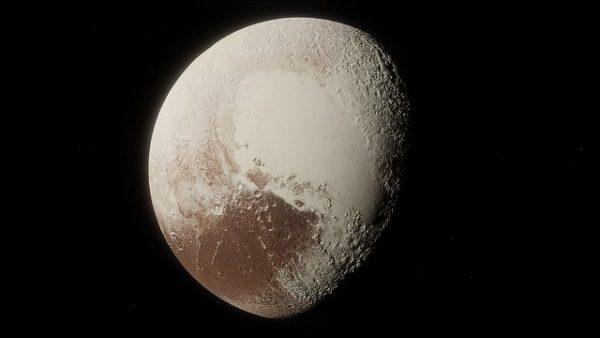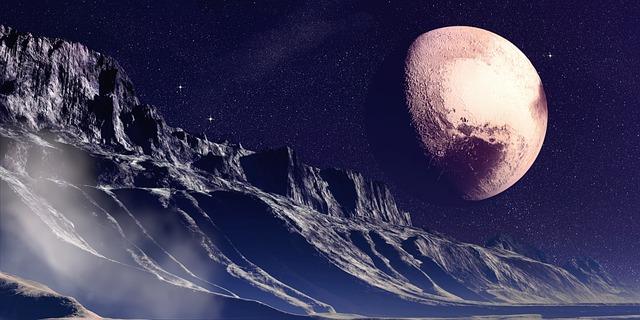- Introduction
- The Moons of Pluto
- The Search for Life on Pluto
- The Future of Pluto Exploration
- The Importance of Studying Pluto
- The Controversy Surrounding Pluto’s Planetary Status
- The IAU’s definition of a planet includes three criteria
- The Geology and Landscape of Pluto
- The Possibility of Life on Pluto
Introduction
Pluto is a dwarf planet located in the Kuiper Belt, a region of the solar system beyond Neptune. Discovered in 1930, Pluto was classified as the ninth planet in the solar system until 2006 when it was reclassified as a dwarf planet due to its small size and irregular orbit. Despite its diminutive size, Pluto has long captured the imagination of scientists and the public alike due to its remote location and unique characteristics.

The Moons of Pluto
In addition to its surface features and atmosphere, Pluto is also home to five known moons: Charon, Nix, Hydra, Kerberos, and Styx. Of these, Charon is the largest and most well-known, as it is approximately half the size of Pluto and is tidally locked with the dwarf planet. This means that Charon always shows the same face to Pluto and is in a constant state of synchronous rotation.
Charon’s surface is also interesting, as it is covered in a variety of features including craters, canyons, and a large chasm that stretches across the moon’s surface. The presence of these features raises questions about the moon’s geology and how it has been shaped over time.
The Search for Life on Pluto
While Pluto is a fascinating object of study, it is also a potential target in the search for extraterrestrial life. While the planet’s surface is inhospitable to life as we know it, the possibility of life existing in the subsurface ocean of Pluto has been proposed. Scientists believe that the heat generated by tidal interactions between Pluto and its largest moon, Charon, could be enough to maintain a subsurface ocean of liquid water.
The Future of Pluto Exploration
Despite the success of the New Horizons mission, there is still much to learn about Pluto and its moons. In the coming years, there are several planned missions to explore the outer solar system, including the possibility of sending a lander to the surface of Pluto.
One of the proposed missions is the Pluto Kuiper Express, which would be a joint mission between NASA and the European Space Agency (ESA). The mission would involve sending a spacecraft to orbit Pluto and its moons, with the goal of studying the planet’s surface, atmosphere, and geology in more detail.
Another proposed mission is the Dragonfly Explorer, which would involve sending a drone-like lander to explore the surface of Pluto and its moons. The lander would be equipped with a suite of scientific instruments, including cameras, spectrometers, and a drill, which would allow it to sample the planet’s surface and subsurface.
The potential for future missions to Pluto is exciting, as they could provide even more insights into this distant and enigmatic world. With each new mission, scientists will be able to refine their understanding of the planet’s history, geology, and potential for harboring life.
The Importance of Studying Pluto
While Pluto may seem like a distant and insignificant world, it is actually a key object of study for astronomers and planetary scientists. Studying Pluto and its moons can provide valuable insights into the early solar system and how it formed.
For example, the presence of nitrogen and methane ice on Pluto’s surface suggests that the planet formed in a different part of the solar system than the gas giants, which are primarily composed of hydrogen and helium. Additionally, studying the moons of Pluto can provide insights into the formation and evolution of the Kuiper Belt, which is a region of the solar system that is thought to contain many small, icy objects.
Furthermore, studying Pluto can also provide insights into the potential for life beyond Earth. While the planet’s surface is inhospitable to life, the possibility of a subsurface ocean of liquid water raises the possibility of microbial life existing on Pluto.
The Controversy Surrounding Pluto’s Planetary Status
Despite the many scientific discoveries and insights that the study of Pluto has provided, there has also been controversy surrounding the planet’s planetary status. In 2006, the International Astronomical Union (IAU) redefined the definition of a planet, which led to Pluto being reclassified as a “dwarf planet.”
The IAU’s definition of a planet includes three criteria
The object must be in orbit around the sun, it must be spherical in shape, and it must have “cleared its orbit” of other debris. According to this definition, Pluto is no longer considered a planet because it has not cleared its orbit of other debris.
This decision was controversial and sparked a debate among astronomers and the public. Some argued that Pluto should remain classified as a planet, citing its unique characteristics and historical significance. Others supported the IAU’s decision, arguing that the definition of a planet should be based on scientific criteria and not sentimental attachments.
The debate surrounding Pluto’s planetary status continues to this day, with some calling for a reevaluation of the IAU’s definition of a planet. Regardless of its classification, however, Pluto remains a fascinating and important object of study in our solar system.
The Geology and Landscape of Pluto
One of the most fascinating aspects of Pluto is its geology and landscape. The New Horizons mission revealed a world with a complex and varied surface, featuring mountains, glaciers, and vast plains of nitrogen ice.
One of the most striking features of Pluto’s landscape is its “heart,” which is a large, bright feature on the planet’s surface. The heart is thought to be a region of relatively young terrain, which suggests that the planet may still be geologically active.
Pluto’s surface is also marked by a number of mountain ranges, including the Tenzing Montes and Hillary Montes. These mountains are thought to be made of water ice and rise to heights of several kilometers above the surrounding terrain.
Another notable feature of Pluto’s landscape is its “Sputnik Planum,” which is a vast, flat plain of nitrogen ice. The plain is marked by polygonal shapes, which are thought to be caused by the convection of nitrogen ice beneath the surface.
The Geology and Landscape of Pluto offer many opportunities for scientific discovery and exploration. By studying the planet’s surface features and terrain, scientists can gain insights into the planet’s history and evolution.
The Moons of Pluto: Pluto has five known moons, Charon being the largest and most well-known. The other moons are Styx, Nix, Kerberos, and Hydra, which were all discovered by the Hubble Space Telescope between 2005 and 2012.
Charon is the largest of Pluto’s moons and is so large that it is sometimes referred to as a “binary planet system” rather than a planet and its moon. Charon is about half the size of Pluto and has a surface marked by deep canyons and mountains. The gravity of Charon also causes a wobble in Pluto’s orbit, which has helped astronomers to determine the mass of both objects.
The other four moons of Pluto are much smaller and have irregular shapes. Styx and Nix are roughly the same size and are thought to have formed from the same collision that created Charon. Kerberos and Hydra are even smaller and have highly irregular shapes.
The study of Pluto’s moons is an important area of research for astronomers and planetary scientists. By studying the composition and behavior of these moons, scientists can gain insights into the formation and evolution of the Pluto system.
The Possibility of Life on Pluto:
Another factor that could potentially support life on Pluto is the presence of organic molecules. Organic molecules are carbon-based compounds that are necessary for life as we know it. While the New Horizons mission did not detect any organic molecules on Pluto’s surface, it did detect evidence of them in the planet’s atmosphere. This suggests that organic molecules may be present on Pluto’s surface, potentially providing the building blocks for life.
However, it is important to note that even if subsurface oceans and organic molecules are present on Pluto, it is still unlikely that life as we know it could exist there. The planet’s extremely cold temperatures, lack of atmosphere, and harsh radiation environment make it an inhospitable place for life to thrive. Additionally, any potential life on Pluto would have to be radically different from life on Earth in order to survive in such an extreme environment.







